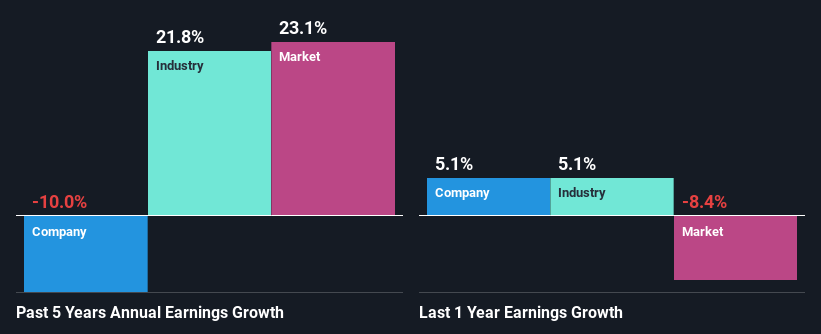
Westshore Terminals Investment’s (TSE:WTE) stock up by 8.9% over the past three months. We wonder if and what role the company’s financials play in that price change as a company’s long-term fundamentals usually dictate market outcomes. In this article, we decided to focus on Westshore Terminals Investment’s ROE.
Return on equity or ROE is a key measure used to assess how efficiently a company’s management is utilizing the company’s capital. In other words, it is a profitability ratio which measures the rate of return on the capital provided by the company’s shareholders.
View our latest analysis for Westshore Terminals Investment
How To Calculate Return On Equity?
The formula for return on equity is:
Return on Equity = Net Profit (from continuing operations) ÷ Shareholders’ Equity
So, based on the above formula, the ROE for Westshore Terminals Investment is:
13% = CA$96m ÷ CA$740m (Based on the trailing twelve months to September 2023).
The ‘return’ is the yearly profit. One way to conceptualize this is that for each CA$1 of shareholders’ capital it has, the company made CA$0.13 in profit.
What Has ROE Got To Do With Earnings Growth?
So far, we’ve learned that ROE is a measure of a company’s profitability. Based on how much of its profits the company chooses to reinvest or “retain”, we are then able to evaluate a company’s future ability to generate profits. Assuming everything else remains unchanged, the higher the ROE and profit retention, the higher the growth rate of a company compared to companies that don’t necessarily bear these characteristics.
A Side By Side comparison of Westshore Terminals Investment’s Earnings Growth And 13% ROE
To start with, Westshore Terminals Investment’s ROE looks acceptable. Even when compared to the industry average of 14% the company’s ROE looks quite decent. As you might expect, the 10% net income decline reported by Westshore Terminals Investment is a bit of a surprise. We reckon that there could be some other factors at play here that are preventing the company’s growth. Such as, the company pays out a huge portion of its earnings as dividends, or is faced with competitive pressures.
So, as a next step, we compared Westshore Terminals Investment’s performance against the industry and were disappointed to discover that while the company has been shrinking its earnings, the industry has been growing its earnings at a rate of 22% over the last few years.


Earnings growth is an important metric to consider when valuing a stock. The investor should try to establish if the expected growth or decline in earnings, whichever the case may be, is priced in. Doing so will help them establish if the stock’s future looks promising or ominous. Is Westshore Terminals Investment fairly valued compared to other companies? These 3 valuation measures might help you decide.
Is Westshore Terminals Investment Making Efficient Use Of Its Profits?
Westshore Terminals Investment has a high three-year median payout ratio of 61% (that is, it is retaining 39% of its profits). This suggests that the company is paying most of its profits as dividends to its shareholders. This goes some way in explaining why its earnings have been shrinking. With only a little being reinvested into the business, earnings growth would obviously be low or non-existent. You can see the 2 risks we have identified for Westshore Terminals Investment by visiting our risks dashboard for free on our platform here.
Additionally, Westshore Terminals Investment has paid dividends over a period of at least ten years, which means that the company’s management is determined to pay dividends even if it means little to no earnings growth. Our latest analyst data shows that the future payout ratio of the company is expected to rise to 107% over the next three years.
Conclusion
Overall, we feel that Westshore Terminals Investment certainly does have some positive factors to consider. Yet, the low earnings growth is a bit concerning, especially given that the company has a high rate of return. Investors could have benefitted from the high ROE, had the company been reinvesting more of its earnings. As discussed earlier, the company is retaining a small portion of its profits. Having said that, we studied the latest analyst forecasts, and found that analysts are expecting the company’s earnings growth to improve slightly. Sure enough, this could bring some relief to shareholders. To know more about the company’s future earnings growth forecasts take a look at this free report on analyst forecasts for the company to find out more.
Have feedback on this article? Concerned about the content? Get in touch with us directly. Alternatively, email editorial-team (at) simplywallst.com.
This article by Simply Wall St is general in nature. We provide commentary based on historical data and analyst forecasts only using an unbiased methodology and our articles are not intended to be financial advice. It does not constitute a recommendation to buy or sell any stock, and does not take account of your objectives, or your financial situation. We aim to bring you long-term focused analysis driven by fundamental data. Note that our analysis may not factor in the latest price-sensitive company announcements or qualitative material. Simply Wall St has no position in any stocks mentioned.
